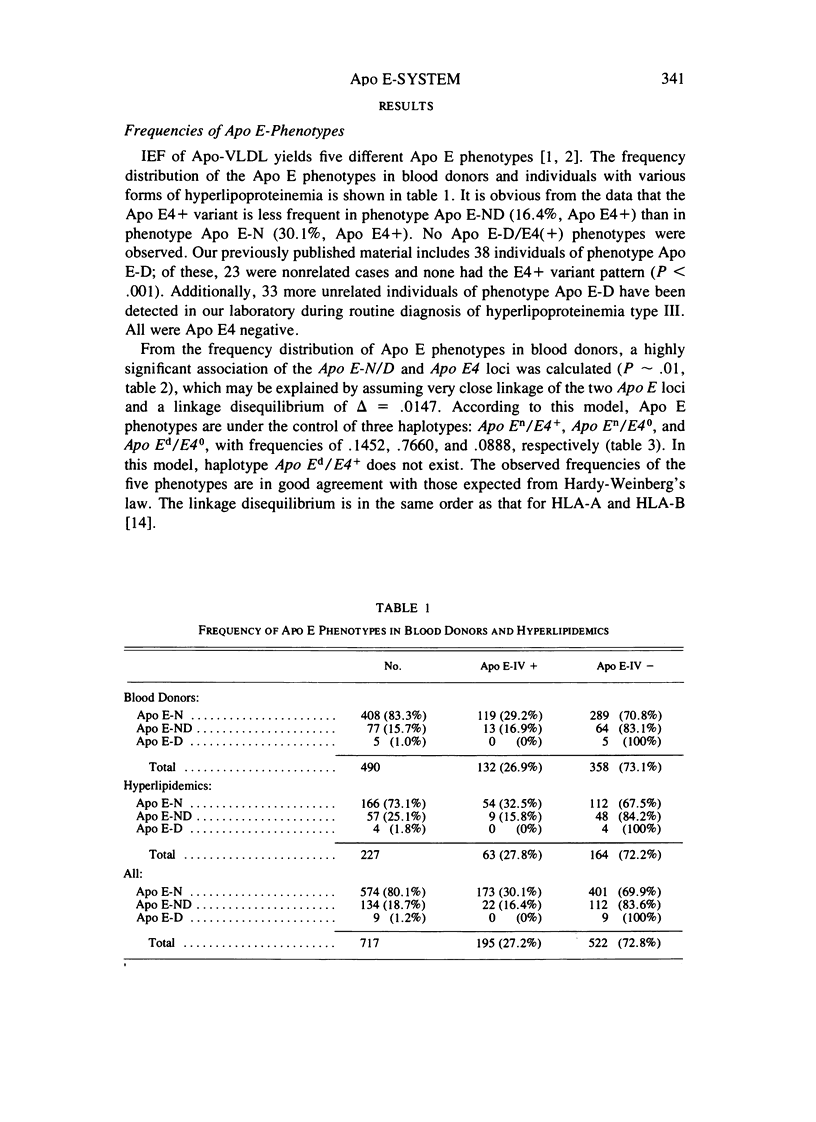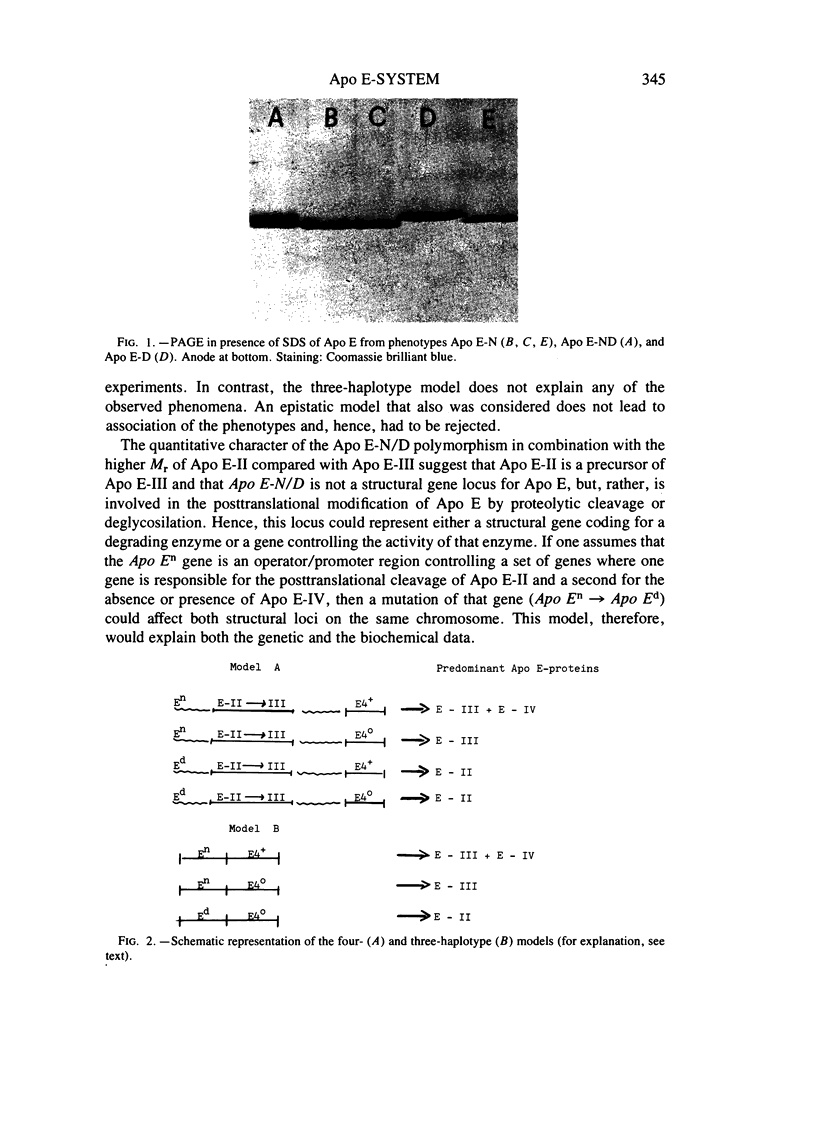Abstract
The polymorphism of apolipoprotein E (Apo E) in man is controlled by two codominant alleles, Apo En and Apo Ed, at the Apo E-N/D locus and by two alleles, the dominant, Apo E4+, and the recessive, Apo E4o, at the Apo E4 locus.
Frequency distribution analysis of Apo E phenotypes demonstrated a highly significant association between both systems (P ∼ 1%). The Apo E4-(+) variant was about twice as frequent in phenotype Apo E-N (30.1%) than in phenotype Apo E-ND (16.4%). The phenotypic combination Apo E-D/-E4(+) was not observed. The segregation of Apo E phenotypes in informative matings is consistent with a close linkage of both loci.
The results may be explained by different models. On the basis of the present data, these models cannot be distinguished by formal genetic criteria. (1) Haplotypes Apo En/E4+, Apo En/E4o, and Apo Ed/E4o determine the different phenotypes, and a linkage disequilibrium exists of Δ = .0147 between the E-N/D and E4 loci. (2) The fourth haplotype, Apo Ed/E4+, exists, but the gene E4+ is not expressed in coupling with Apo Ed. The four-haplotype model seems more attractive in view of Apo E-N/D polymorphism's quantitative character and of biochemical results, which show that phenotypes Apo E-N and Apo E-D differ in the apparent molecular weight (Mr) of the respective major Apo E polymorphic form. Hence, the Apo E-N/D locus may control structural genes involved in the posttranslational modification of Apo E. (3) Finally, there may exist only one Apo E structural gene locus but with mutations at two sites susceptible to posttranslational modification.
Full text
PDF








Images in this article
Selected References
These references are in PubMed. This may not be the complete list of references from this article.
- Neville D. M., Jr Molecular weight determination of protein-dodecyl sulfate complexes by gel electrophoresis in a discontinuous buffer system. J Biol Chem. 1971 Oct 25;246(20):6328–6334. [PubMed] [Google Scholar]
- Utermann G., Albrecht G., Steinmetz A. Polymorphism of apolipoprotein E. I. Methodological aspects and diagnosis of hyperlipoproteinemia type III without ultracentrifugation. Clin Genet. 1978 Dec;14(6):351–358. [PubMed] [Google Scholar]
- Utermann G., Canzler H., Hees M., Jaeschke M., Mühlfellner G., Schoenborn W., Vogelberg K. H. Studies on the metabolic defect in Broad-beta disease (hyperlipoproteinaemia type III). Clin Genet. 1977 Sep;12(3):139–154. doi: 10.1111/j.1399-0004.1977.tb00917.x. [DOI] [PubMed] [Google Scholar]
- Utermann G., Hees M., Steinmetz A. Polymorphism of apolipoprotein E and occurrence of dysbetalipoproteinaemia in man. Nature. 1977 Oct 13;269(5629):604–607. doi: 10.1038/269604a0. [DOI] [PubMed] [Google Scholar]
- Utermann G. Isolation and partial characterization of an arginine-rich apolipoprotein from human plasma very-low-density lipoproteins: apolipoprotein E. Hoppe Seylers Z Physiol Chem. 1975 Jul;356(7):1113–1121. doi: 10.1515/bchm2.1975.356.2.1113. [DOI] [PubMed] [Google Scholar]
- Utermann G., Jaeschke M., Menzel J. Familial hyperlipoproteinemia type III: deficiency of a specific apolipoprotein (apo E-III) in the very-low-density lipoproteins. FEBS Lett. 1975 Aug 15;56(2):352–355. doi: 10.1016/0014-5793(75)81125-2. [DOI] [PubMed] [Google Scholar]
- Utermann G., Pruin N., Steinmetz A. Polymorphism of apolipoprotein E. III. Effect of a single polymorphic gene locus on plasma lipid levels in man. Clin Genet. 1979 Jan;15(1):63–72. [PubMed] [Google Scholar]
- Utermann G., Vogelberg K. H., Steinmetz A., Schoenborn W., Pruin N., Jaeschke M., Hees M., Canzler H. Polymorphism of apolipoprotein E. II. Genetics of hyperlipoproteinemia type III. Clin Genet. 1979 Jan;15(1):37–62. [PubMed] [Google Scholar]
- Utermann G., Weber W., Beisiegel U. Different mobility in SDS--polyacrylamide gel electrophoresis of apolipoprotein E from phenotypes apo E-N and Apo E-D. FEBS Lett. 1979 May 1;101(1):21–26. [PubMed] [Google Scholar]



